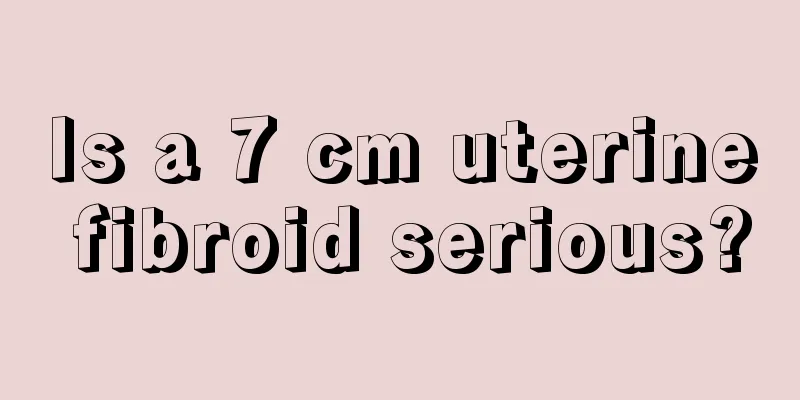Is a 7 cm uterine fibroid serious?

|
Uterine fibroids are a benign gynecological disease of the uterus. Although it is benign, it also has the possibility of malignant transformation. If you suffer from uterine fibroids, you must seek timely treatment and take it seriously, especially if the uterine fibroids are already seven centimeters, which is already very large. If not treated in time, it will cause irregular menstruation in women. For women who want to have children, it will affect their fertility, so timely treatment is necessary. What to do if uterine fibroids are 7 cm It is best to have surgery. 1. Irregular menstruation Irregular menstruation with increased menstrual flow and prolonged menstrual period is the most common symptom of uterine fibroids. It is more common in large intramural fibroids and submucosal fibroids. Fibroids enlarge the uterine cavity, increase the area of the endometrium and affect uterine contraction. In addition, fibroids may compress the veins near the tumor, causing congestion and dilation of the endometrial venous plexus, thereby causing increased menstrual flow and prolonged menstruation. When submucosal fibroids are accompanied by necrosis and infection, there may be irregular vaginal bleeding or bloody purulent discharge. Long-term excessive menstrual flow may lead to anemia, fatigue, palpitations and other symptoms. 2. Lower abdominal mass When the fibroids are small, no lump can be felt in the abdomen. However, when the fibroids gradually increase in size and the uterus exceeds the size of a 3-month pregnancy, they can be felt from the abdomen. Giant submucosal fibroids can prolapse outside the vagina, and patients may seek medical attention due to prolapse of the vulva. 3. Increased leucorrhea Intramural fibroids increase the area of the uterine cavity, increase the secretion of endometrial glands, and are accompanied by pelvic congestion, which leads to increased leucorrhea. Once submucosal uterine fibroids are infected, there may be a large amount of pus-like leucorrhea. If there is ulceration, necrosis, or bleeding, there may be bloody or purulent vaginal discharge with a foul odor. 4. Compression symptoms Fibroids in the lower segment of the anterior wall of the uterus can compress the bladder and cause frequent and urgent urination; cervical fibroids can cause difficulty urinating and urinary retention; fibroids on the posterior wall of the uterus (isthmus or posterior wall) can cause symptoms such as lower abdominal distension and discomfort and constipation. Broad ligament myomas or giant cervical myomas develop laterally, embed into the pelvic cavity, compress the ureter, and cause obstruction of the upper urinary tract, resulting in ureteral dilatation and even hydronephrosis. What are the dangers of uterine fibroids 1. Infertility or miscarriage If fibroid tissue appears in the uterine cornu, it may compress the entrance of the fallopian tube, preventing sperm from ascending to the fallopian tube and combining with the egg, thereby affecting conception; it may cause deformation of the uterus, hinder the implantation of the fertilized egg and hinder conception. Even if the fertilized egg has implanted, larger fibroids combined with pregnancy can easily cause miscarriage due to mechanical obstruction of embryonic development and uterine cavity infection. 2. Cause gynecological inflammation Uterine fibroids can cause pelvic congestion and infection, among which the infection caused by fibroids is mostly caused by pedicle torsion. After infection, abscesses may form in the fibroid tissue of a few patients, and suppuration may occur. At the same time, pathogenic bacteria after fibroid infection can invade other nearby organs, causing gynecological diseases such as adnexitis and pelvic inflammatory disease. 3. Secondary anemia Uterine fibroids can cause excessive menstrual bleeding in patients. Over time, patients will develop secondary anemia, manifested by symptoms such as general fatigue, pale complexion, palpitations and shortness of breath. 4. Malignant lesions In a minority of women, malignant changes in uterine fibroids may turn into sarcomas, which can cause vaginal bleeding and lower abdominal pain. In late stages, the fibroids can spread through the bloodstream, directly spread, and metastasize to multiple parts of the body through the lymph nodes. |
<<: The dangers of removing uterine fibroids
>>: Is a 4 cm uterine fibroid serious?
Recommend
What medicine should women take for neurasthenia
Neurasthenia is a condition that is most likely t...
Does inflammation of the cervix affect pregnancy?
Inflammation of the cervix will seriously affect ...
Sensor Tower: European Payment Application Report 2021
Sensor Tower has released the “2021 European Paym...
Is it better to eat while standing or sitting? It depends on whether you want to lose weight or gain weight
Written by Su Chengyu Most people eat while sitti...
How should French fries be fried? How to make French fries in an air fryer?
Many young people like to eat French fries at McDo...
Animals can also become "addicts"! How do drugs make the brain addicted?
Maybe you have seen the dog in the picture below,...
Picture of eight-month-old fetus in the belly
After nine months of pregnancy, the fetus is almo...
Can I have sex the day before my prenatal checkup?
Pregnancy check-ups are necessary during pregnanc...
What causes right abdominal pain in pregnant women?
During pregnancy, pregnant women often feel pain ...
Can uterine prolapse recover?
Women will encounter various unexpected problems ...
Is a sore throat a sign of "Er Yang"? Here's what you need to know about "Er Yang"
Recently, many people have experienced sore throa...
Can I get pregnant if I have sex two days after taking birth control pills?
As the saying goes: People make mistakes and hors...
Chinese medicine teaches you eight tips to improve your body's immunity!
There is a famous saying in traditional Chinese m...
How long after medical abortion can menstruation come at the latest?
Nowadays, people have more open ideas about sex l...


![[Popular Science Lecture] Sometimes dizziness is caused by problems with your cervical spine](/upload/images/67f18bb38fe9b.webp)






